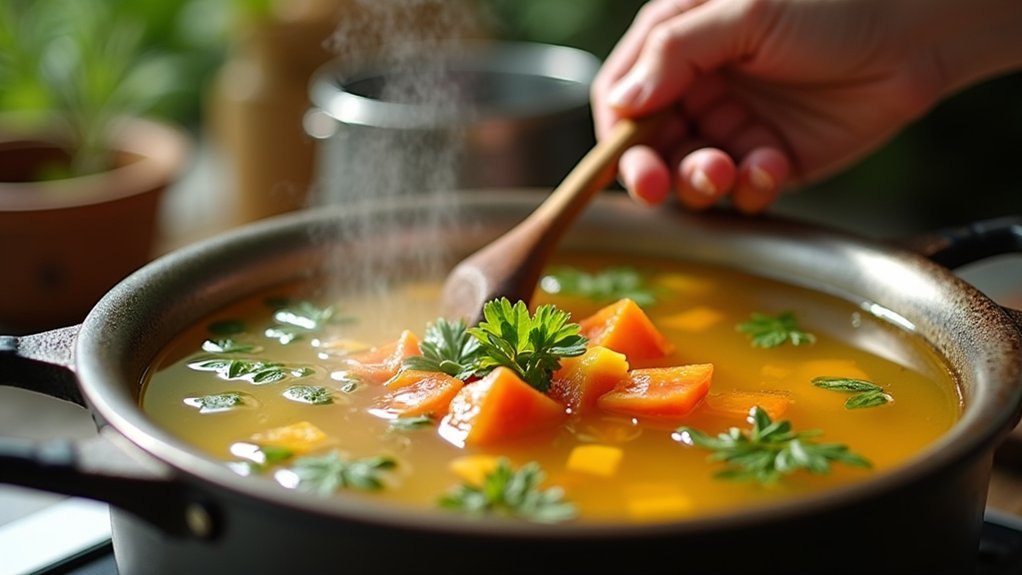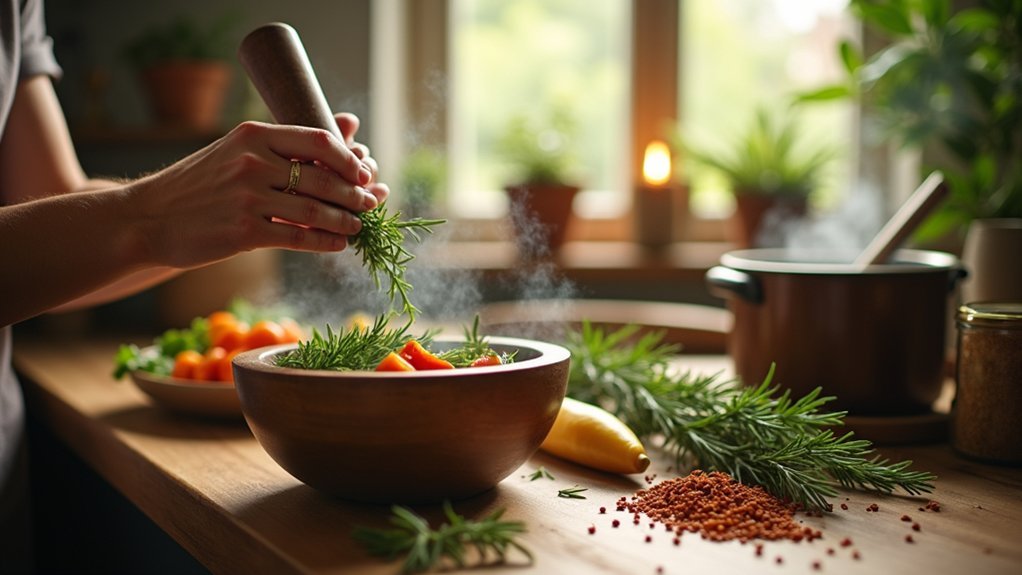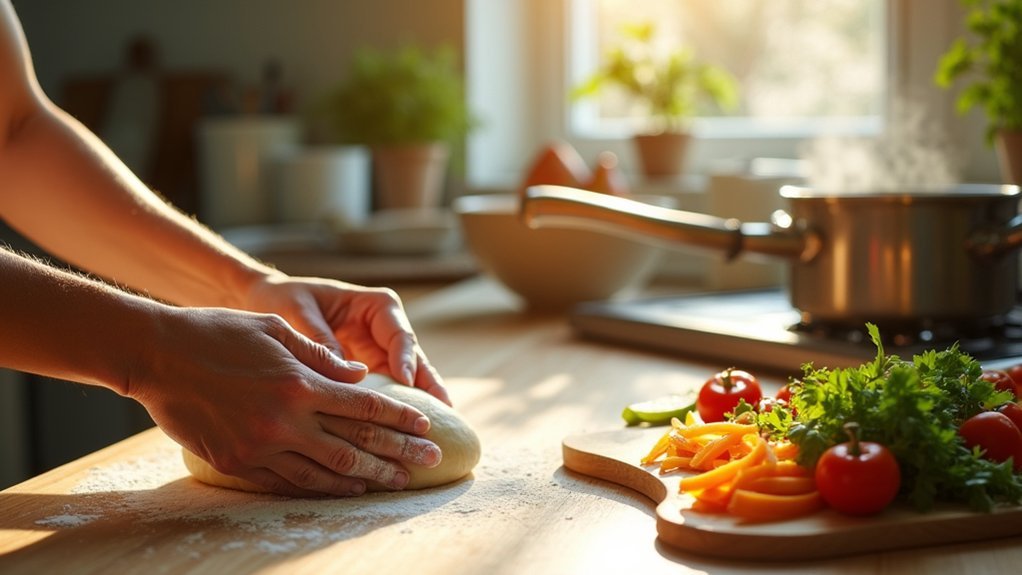When you need to calm your mind, try these three therapeutic cooking techniques: mindful stirring with a wooden spoon, focusing on the rhythm and sensory experience; temperature techniques that engage different senses through hot simmering or invigorating cold preparation; and aroma therapy using culinary herbs and essential oils that reduce stress while enhancing flavors. These approaches transform ordinary cooking into a meditative practice that grounds you in the present moment. The kitchen holds more healing potential than you might realize.
Mindful Stirring: The Rhythmic Path to Sensory Grounding

When you pick up a wooden spoon and begin to stir a simmering pot, you’re not just mixing ingredients—you’re entering a gateway to mindfulness. The repetitive motion creates a natural rhythm that can quiet your busy mind and anchor you in the present moment.
Focus on each sensory element: feel the weight of the utensil in your hand, listen to the gentle sound of sauce swirling against the pot, and watch ingredients transform before your eyes. This sensory engagement is a powerful way to practice mindful awareness, which therapists recognize as beneficial for mental health.
This deliberate attention turns a routine cooking task into a meditative practice that reduces stress and anxiety.
Try incorporating deep, rhythmic breathing as you stir, matching your breath to your movements.
You’ll find that this simple act of culinary mindfulness can provide therapeutic relief when your thoughts feel scattered.
Temperature Technique: Therapeutic Benefits of Hot and Cold Food Preparation
Have you ever noticed how your mood shifts when handling a steaming pot versus preparing a crisp salad? This temperature contrast offers distinct therapeutic benefits.
Hot preparation activates fine motor skills while releasing calming aromas that reduce stress. The warmth stimulates circulation and enhances nutrient bioavailability. When you simmer, boil, or steam foods, you’re not just making them safer—you’re transforming their texture into something comforting and digestible. Although steaming is particularly beneficial as it preserves water-soluble vitamins with only minimal losses compared to other cooking methods.
Meanwhile, cold preparation preserves delicate nutrients and natural enzymes. The cooling sensation can reduce agitation and promote calmness.
You’ll maintain the crispness of fresh ingredients while avoiding potentially harmful compounds that form during heating.
Aroma Therapy: Harnessing Scent in the Healing Kitchen

The kitchen transforms into a sanctuary of healing scents when you incorporate aromatherapy into your cooking routine. Essential oils from herbs like thyme and rosemary don’t just enhance flavor—they contain compounds that protect cells and boost immune response.
When you chop fresh herbs or add a drop of culinary-grade essential oil, you’re engaging in mindfulness that reduces stress and anxiety. The aromatic compounds actually modulate your mood and physiological responses, creating calming effects.
Remember that essential oils are potent—use only those specifically marketed for culinary purposes and in minimal quantities. Always dilute essential oils with a fat source like olive oil or honey to ensure even distribution and reduce the risk of tissue damage.
Cinnamon, cumin, coriander, and citrus oils offer antimicrobial benefits while supporting digestive and cardiovascular health. The combination of aromatic engagement with tactile cooking actions synergistically reduces blood pressure and improves breathing patterns.
Frequently Asked Questions
Can Cooking Therapy Help With Specific Trauma Recovery?
Yes, cooking therapy can help you recover from trauma by providing healthy coping mechanisms, reducing anxiety, creating structure, and offering emotional expression. It’s especially effective when integrated with other treatment approaches.
How Do Cooking Interventions Compare to Traditional Talk Therapy?
Unlike talk therapy where you’re discussing feelings, cooking interventions engage your senses and require physical action. You’re learning practical skills that distract from negative thoughts while still processing emotions through a different medium.
Are Therapeutic Cooking Benefits Scientifically Proven?
Yes, research has scientifically proven therapeutic cooking benefits. You’ll find evidence showing cooking reduces stress, improves mood, enhances self-esteem, and promotes mindfulness. However, the field still needs more thorough clinical studies.
Can Children Benefit From Therapeutic Cooking Techniques?
Yes, your children can benefit greatly from therapeutic cooking. They’ll experience emotional relief, develop social skills, enhance cognitive abilities, and learn healthy eating habits through hands-on cooking activities and food preparation.
How Long Should Cooking Therapy Sessions Last for Optimal Results?
For best results, you’ll find 2-3 hour cooking therapy sessions most effective. This duration allows you enough time for education, hands-on cooking, mindful eating, and valuable group discussion without causing fatigue or overwhelming you.
In Summary
You’ll find that these three therapeutic cooking approaches aren’t just about preparing food—they’re about nourishing your soul. Whether you’re rhythmically stirring a risotto, feeling the temperature contrast of baking and chilling, or inhaling the comforting aromas of vanilla and rosemary, you’re practicing mindfulness. Next time you’re feeling overwhelmed, don’t underestimate the healing power waiting in your kitchen. It’s not just cooking; it’s self-care in its most delicious form.





Leave a Reply